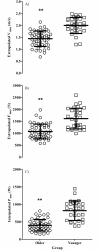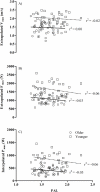Habitual physical activity levels do not predict leg strength and power in healthy, active older adults
- PMID: 29965998
- PMCID: PMC6028110
- DOI: 10.1371/journal.pone.0200089
Habitual physical activity levels do not predict leg strength and power in healthy, active older adults
Abstract
Physical activity is considered crucial in attenuating losses in strength and power associated with ageing. However, in well-functioning, active older adults the relationship between habitual physical activity and muscle function is surprisingly unclear. Leg press velocity, force, and power, were compared between 50 older and 30 younger healthy individuals, and associations with habitual physical activity explored. An incremental power test was performed on a pneumatic leg press, with theoretical maximum velocity, force, and power calculated. Vastus lateralis muscle thickness was measured by ultrasound, and participants wore a combined accelerometer and heart rate monitor for 6-days of free-living. Older individuals produced lower absolute maximum velocity, force, and power, than younger individuals. When accounting for smaller muscle size, older individual's maximum force and power remained markedly lower. Both groups were active, however using age specific thresholds for classifying physical activity, the older individuals engaged in twice the amount of moderate-to-vigorous physical activity in comparison to the younger individuals. There were no associations between any characteristics of muscle function and physical activity. These data support that the ability to generate force and power deteriorates with age, however habitual physical activity levels do not explain inter-individual differences in muscle function in active older individuals.
Conflict of interest statement
The authors have declared that no competing interests exist.
Figures



References
-
- Walston JD. Sarcopenia in older adults. Curr Opin Rheumatol. 2012;24(6):623–7 doi: 10.1097/BOR.0b013e328358d59b - DOI - PMC - PubMed
-
- den Ouden MEM, Schuurmans MJ, Arts I, van der Schouw YT. Association between physical performance characteristics and independence in activities of daily living in middle-aged and elderly men. Geriatr Gerontol Int. 2013;13(2):274–80. doi: 10.1111/j.1447-0594.2012.00890.x - DOI - PubMed
-
- Fukunaga T, Miyatani M, Tachi M, Kouzaki M, Kawakami Y, Kanehisa H. Muscle volume is a major determinant of joint torque in humans. Acta Physiol Scand. 2001;172(4):249–55. doi: 10.1046/j.1365-201x.2001.00867.x - DOI - PubMed
-
- Goodpaster BH, Park SW, Harris TB, Kritchevsky SB, Nevitt M, Schwartz AV, et al. The loss of skeletal muscle strength, mass, and quality in older adults: The health, aging and body composition study. J Gerontol A Biol Sci Med Sci. 2006;61(10):1059–64. - PubMed
Publication types
MeSH terms
LinkOut - more resources
Full Text Sources
Other Literature Sources
Medical

